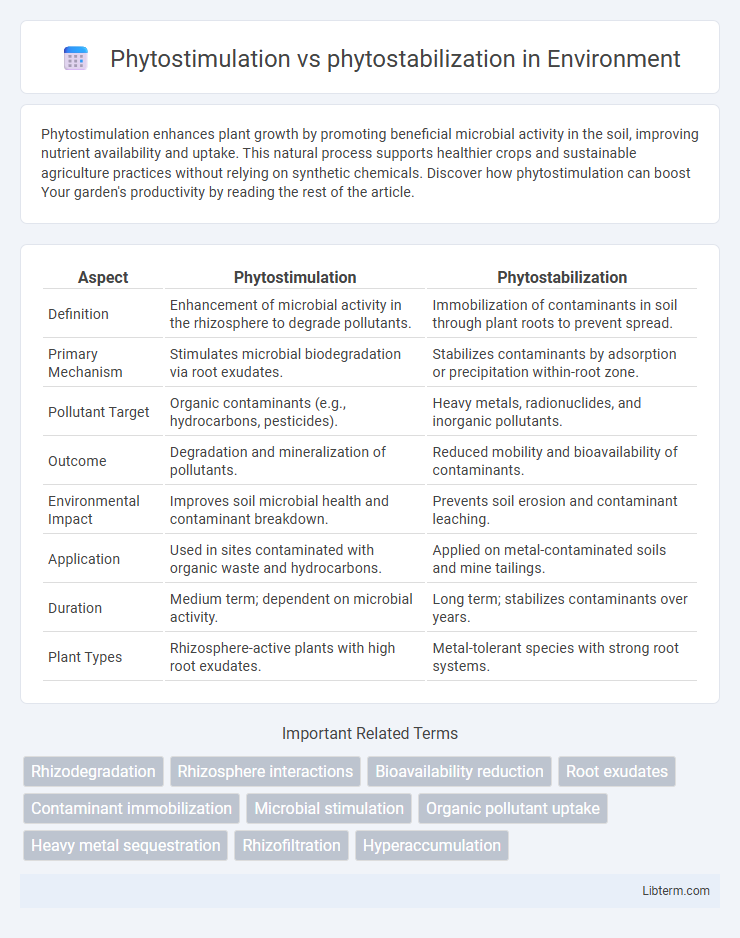Phytostimulation enhances plant growth by promoting beneficial microbial activity in the soil, improving nutrient availability and uptake. This natural process supports healthier crops and sustainable agriculture practices without relying on synthetic chemicals. Discover how phytostimulation can boost Your garden's productivity by reading the rest of the article.
Table of Comparison
| Aspect | Phytostimulation | Phytostabilization |
|---|---|---|
| Definition | Enhancement of microbial activity in the rhizosphere to degrade pollutants. | Immobilization of contaminants in soil through plant roots to prevent spread. |
| Primary Mechanism | Stimulates microbial biodegradation via root exudates. | Stabilizes contaminants by adsorption or precipitation within-root zone. |
| Pollutant Target | Organic contaminants (e.g., hydrocarbons, pesticides). | Heavy metals, radionuclides, and inorganic pollutants. |
| Outcome | Degradation and mineralization of pollutants. | Reduced mobility and bioavailability of contaminants. |
| Environmental Impact | Improves soil microbial health and contaminant breakdown. | Prevents soil erosion and contaminant leaching. |
| Application | Used in sites contaminated with organic waste and hydrocarbons. | Applied on metal-contaminated soils and mine tailings. |
| Duration | Medium term; dependent on microbial activity. | Long term; stabilizes contaminants over years. |
| Plant Types | Rhizosphere-active plants with high root exudates. | Metal-tolerant species with strong root systems. |
Introduction to Phytoremediation
Phytostimulation involves the enhancement of microbial activity in the rhizosphere to degrade soil contaminants through root exudates, promoting bioremediation. In contrast, phytostabilization uses plants to immobilize pollutants in the soil, reducing their bioavailability and preventing further environmental spread. Both techniques serve as essential components of phytoremediation, a sustainable approach utilizing plants to remediate contaminated sites.
Defining Phytostimulation
Phytostimulation refers to the enhancement of microbial activity in the rhizosphere through the release of root exudates, promoting biodegradation of contaminants. This process leverages plant-microbe interactions to accelerate the breakdown of organic pollutants in soil and groundwater. In contrast, phytostabilization involves using plants to immobilize contaminants, preventing their migration without degrading them.
Defining Phytostabilization
Phytostabilization is a remediation technique that immobilizes contaminants in soil, preventing their migration and reducing bioavailability through the use of plants. Unlike phytostimulation, which enhances microbial degradation of pollutants, phytostabilization focuses on stabilizing contaminants by root absorption, precipitation, or adsorption. This method is particularly effective for heavy metal-contaminated sites where preventing toxin spread is crucial for environmental safety.
Mechanisms Behind Phytostimulation
Phytostimulation involves enhancing microbial activity in the rhizosphere through root exudates such as sugars, amino acids, and organic acids, which stimulate biodegradation of contaminants. This mechanism promotes the breakdown of pollutants by increasing microbial population and enzymatic activity near plant roots. In contrast, phytostabilization primarily immobilizes contaminants in soil, preventing their migration without degrading them.
Mechanisms Behind Phytostabilization
Phytostabilization involves the use of plants to immobilize contaminants in soil and groundwater, preventing their migration through root absorption and rhizosphere interactions. Key mechanisms include the adsorption of pollutants onto root surfaces, precipitation of metals through root exudates, and the alteration of soil pH and redox conditions to reduce contaminant bioavailability. This process contrasts with phytostimulation, which primarily enhances microbial degradation of pollutants by promoting microbial activity in the rhizosphere.
Key Differences: Phytostimulation vs Phytostabilization
Phytostimulation involves the enhancement of microbial activity in the rhizosphere to accelerate the degradation of contaminants, whereas phytostabilization focuses on immobilizing pollutants in the soil to prevent their spread. Phytostimulation leverages root exudates to promote biodegradation, while phytostabilization relies on plant roots to physically and chemically stabilize contaminants. The primary difference lies in phytostimulation targeting contaminant breakdown and phytostabilization aiming at contaminant containment.
Environmental Applications of Phytostimulation
Phytostimulation enhances the biodegradation of contaminants by stimulating microbial activity in the rhizosphere, making it effective for remediating organic pollutants such as petroleum hydrocarbons and chlorinated solvents. This process relies on root exudates that increase microbial populations and enzymatic reactions, accelerating the breakdown of toxic compounds in soil and groundwater. Environmental applications of phytostimulation include treatment of petroleum-contaminated sites, industrial waste areas, and agricultural lands affected by pesticide residues, offering a sustainable alternative to conventional remediation methods.
Environmental Applications of Phytostabilization
Phytostabilization involves the use of plants to immobilize contaminants in soil, preventing their migration and reducing environmental hazards, whereas phytostimulation enhances microbial activity in the rhizosphere to degrade pollutants. Environmental applications of phytostabilization include the stabilization of heavy metals in mine tailings, preventing soil erosion, and minimizing groundwater contamination. This technique is especially effective in remediating contaminated sites with high metal concentrations by promoting root absorption and precipitation of pollutants within the soil matrix.
Advantages and Limitations of Each Approach
Phytostimulation enhances microbial activity in the rhizosphere to accelerate contaminant degradation, offering advantages such as increased bioavailability and faster pollutant breakdown, but it is limited by dependency on suitable microbial communities and soil conditions. Phytostabilization immobilizes contaminants in the soil through root adsorption and precipitation, reducing pollutant mobility and exposure risks, yet it does not remove contaminants and may require long-term monitoring to ensure stability. Both approaches are site-specific and effectiveness depends on soil type, contaminant nature, and environmental factors.
Choosing the Right Technique for Soil Remediation
Phytostimulation enhances the degradation of contaminants in soil through the stimulation of microbial activity using plant root exudates, making it ideal for soils with bioavailable pollutants like hydrocarbons. Phytostabilization involves immobilizing contaminants by absorbing or adsorbing them in plant roots and soil particles, preventing their migration in heavy metal-contaminated sites. Choosing the right technique depends on contaminant type, soil conditions, and remediation goals, with phytostimulation favored for biodegradable compounds and phytostabilization suited for immobilizing toxic metals.
Phytostimulation Infographic

 libterm.com
libterm.com